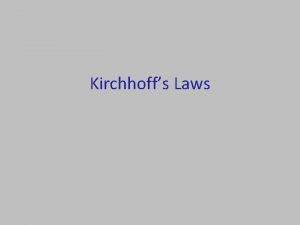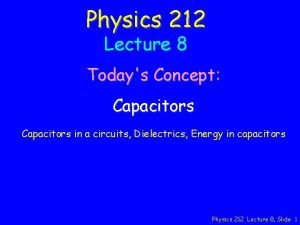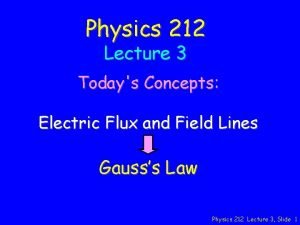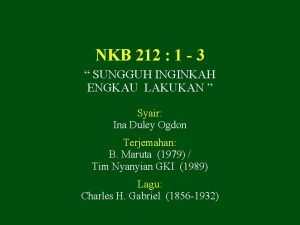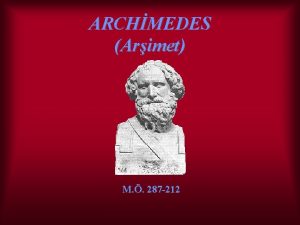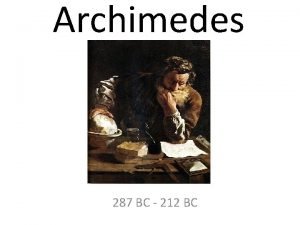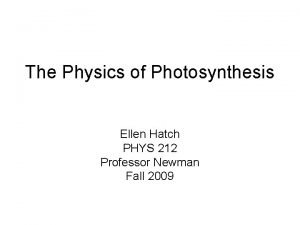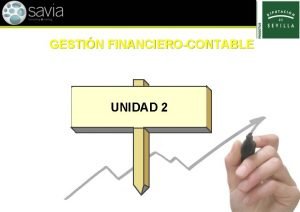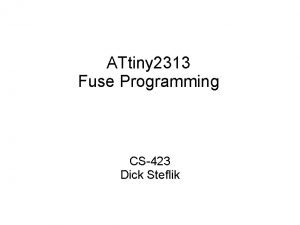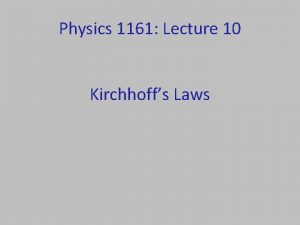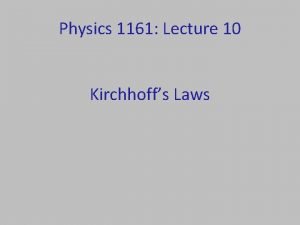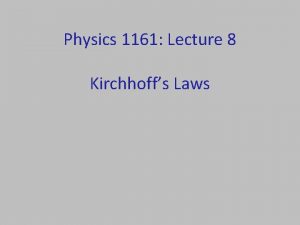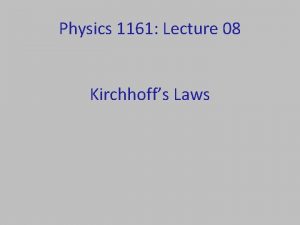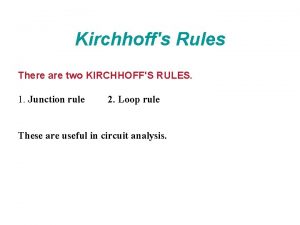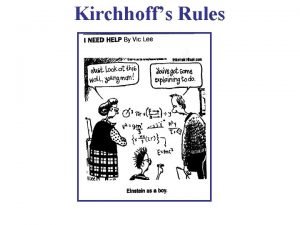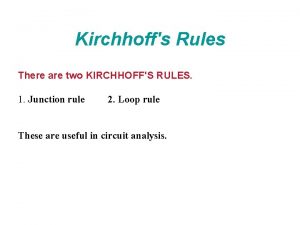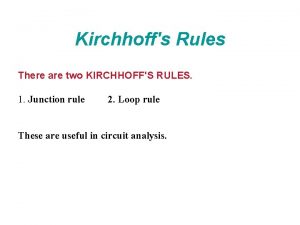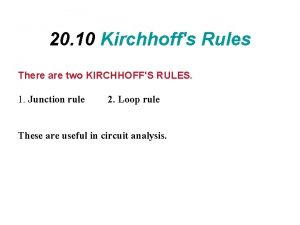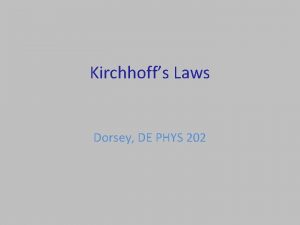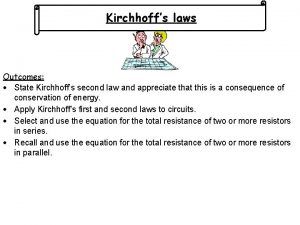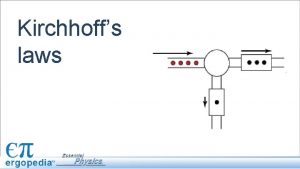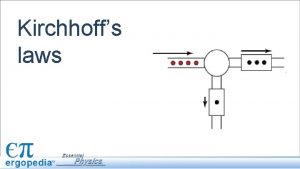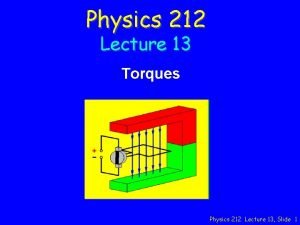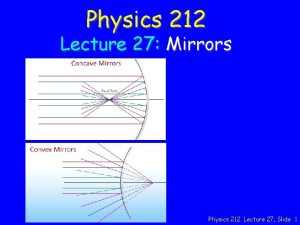Physics 212 Lecture 10 Kirchhoffs Rules Physics 212





















- Slides: 21

Physics 212 Lecture 10 Kirchhoff’s Rules Physics 212 Lecture 10, Slide 1

Last Time Resistors in series: Current through is same. Voltage drop across is IRi Resistors in parallel: Voltage drop across is same. Current through is V/Ri Solved Circuits R 1 V R 2 = R 3 V I 1234 R 4 Physics 212 Lecture 10, Slide 2 5

New Circuit R 1 R 3 V 1 V 2 R 2 How Can We Solve This One? R 1 V 2 R 3 R 2 = V I 1234 R 12 THE ANSWER: Kirchhoff’s Rules Physics 212 Lecture 10, Slide 3 5

Kirchoff’s Voltage Rule Kirchoff's Voltage Rule states that the sum of the voltage changes around a circuit must be zero. WHY? The potential difference between a point and itself is zero ! 2 1 3 Physics 212 Lecture 10, Slide 4

2 1 3 True for any loop Add the voltage “drops” ( V 1 -V 2) + (V 2 -V 3) + (V 3 -V 1) = 0 or The voltage “gains” , ( V 2 -V 1) + (V 3 -V 2) + (V 1 -V 3) = 0

Kirchoff’s Current Rule Kirchoff's Current Rule states that the sum of all currents entering any given point in a circuit must equal the sum of all currents leaving the same point. WHY? Electric charge is conserved and cannot accumulate at nodes. Node I 2 I 1 I 4 I 3 Physics 212 Lecture 10, Slide 6

Checkpoint 2 GAIN In the following circuit, consider the loop abc. The direction of the current through each resistor is indicated by black arrows. DROP N I A G If we are to write Kirchoff's voltage equation for this loop in the clockwise direction starting from point a, what is the correct order of voltage gains/drops that we will encounter for resistors R 1, R 2 and R 3? A drop, drop A. B. gain, gain C. drop, gain B D. E. gain, drop C gain, drop D E With the current VOLTAGE DROP Against the current VOLTAGE GAIN Physics 212 Lecture 10, Slide 7

V 1 R 1 + + - V 2 R 2 - + + R 3 - - I 2 In this circuit, assume Vi and Ri are known. What is I 2 ? - V 3 + + I 1 Calculation I 3 - (1) Label and pick directions for each current (2) Label the + and – side of each element This is easy for batteries. For resistors, the “upstream” side is +. Now write down loop and node equations. Physics 212 Lecture 10, Slide 8

V 1 R 1 + + - V 2 R 2 - + + R 3 - - I 2 - V 3 + + I 1 Calculation In this circuit, assume Vi and Ri are known. What is I 2? I 3 - • How many equations do we need to write down in order to solve for I 2? (A) 1 • Why? – – (B) 2 (C) 3 (D) 4 (E) 5 We have 3 unknowns: I 1, I 2, and I 3 We need 3 independent equations to solve for these unknowns (3) Choose loops and directions Physics 212 Lecture 10, Slide 9

V 1 R 1 + + - V 2 R 2 - + + R 3 - - I 2 - V 3 + + I 1 Calculation In this circuit, assume Vi and Ri are known. I 3 What is I 2 ? - • Which of the following equations is NOT correct? (A) (B) (C) (D) I 2 = I 1 + I 3 + V 1 - I 1 R 1 + I 3 R 3 - V 3 = 0 + V 3 - I 3 R 3 - I 2 R 2 - V 2 = 0 + V 2 + I 2 R 2 - I 1 R 1 + V 1 = 0 Node Outer loop Bottom loop Top loop • Why is (D) wrong ? Start at negative terminal of V 2 and go clockwise around top loop: (+V 2) + (+I 2 R 2) + (+I 1 R 1) + (-V 1) = 0 This is not the same as answer (D). Physics 212 Lecture 10, Slide 10

R 1 V 1 R 2 V 2 R 3 V 3 I 1 Calculation I 2 In this circuit, assume Vi and Ri are known. I 3 What is I 2 ? • We have the following 4 equations: 1. 2. 3. 4. I 2 = I 1 + I 3 + V 1 - I 1 R 1 + I 3 R 3 - V 3 = 0 + V 3 - I 3 R 3 - I 2 R 2 - V 2 = 0 + V 2 + I 2 R 2 + I 1 R 1 - V 1 = 0 • Why? – – – Node Outer Bottom Top We need 3 equations: Which 3 should we use? A) Any 3 will do B) 1, 2, and 4 C) 2, 3, and 4 We need 3 INDEPENDENT equations Equations 2, 3, and 4 are NOT INDEPENDENT • Eqn 2 + Eqn 3 = - Eqn 4 We must choose Equation 1 and any two of the remaining ( 2, 3, and 4) Physics 212 Lecture 10, Slide 11

R 1 V 1 R 2 V 2 R 3 R 2 R R V 3 2 V V V I 1 I 2 I 3 Calculation In this circuit, assume Vi and Ri are known. What is I 2? • We have 3 equations and 3 unknowns. I 2 = I 1 + I 3 V 1 - I 1 R 1 + I 3 R 3 - V 3 = 0 V 2 + I 2 R 2 + I 1 R 1 - V 1 = 0 (6) Solve the equations • The solution will get very messy! Simplify: assume V 2 = V 3 = V V 1 = 2 V R 1 = R 3 = R R 2 = 2 R Physics 212 Lecture 10, Slide 12

Calculation: Simplify In this circuit, assume V and R are known. R 2 R R 2 V V V I 1 I 2 What is I 2 ? • We have 3 equations and 3 unknowns. I 2 = I 1 + I 3 +2 V - I 1 R + I 3 R - V = 0 (outside) +V + I 2(2 R) + I 1 R - 2 V = 0 (top) I 3 current direction • With this simplification, you can verify: I 2 = ( 1/5) V/R I 1 = ( 3/5) V/R I 3 = (-2/5) V/R Physics 212 Lecture 10, Slide 13

Follow-Up 2 V R V 2 R a • We know: I 2 = ( 1/5) V/R I 1 = ( 3/5) V/R I 3 = (-2/5) V/R I 2 b R • I 1 V I 3 Suppose we short R 3: (A) Vab remains the same (B) Vab changes sign (C) Vab increases (D) Vab goes to zero What happens to Vab (voltage across R 2? ) Why? Redraw: Bottom Loop Equation: (Va - Vb ) + V - V = 0 Vab = 0 a R 2 V 2 R V b V c I 1 I 2 d I 3 Physics 212 Lecture 10, Slide 14

a V b R R Is there a current flowing between a and b ? A) Yes B) No A & B have the same potential Current flows from battery and splits at A No current flows between A & B Some current flows down Some current flows right Physics 212 Lecture 10, Slide 15

Checkpoint 3 a Consider the circuit shown below. Note that this question is not identical to the similar looking one I 2 you answered in the prelecture. I 2 I I I 2 I Which of the following best describes the current flowing in the blue wire connecting points a and b? 1. Same voltage across R, 2 R in parallel so IR = 2 I 2 R. 2. R, 2 R combinations are identical so voltage drop in each case is V/2. Therefore total current in top and bottom must be 3 I. 3. Satisfy Kirchhoff current law at node a so Iab = I Physics 212 Lecture 10, Slide 16

Prelecture What is the same? Checkpoint Current flowing in and out of the battery 2 R 3 What is different? Current flowing from a to b Physics 212 Lecture 10, Slide 17

I 2/ 3 I V R 1/ 3 I a 2/ 2/ 3 I 2 R b R 1/ 3 I V/2 2 R 3 I 0 2/ 3 I Physics 212 Lecture 10, Slide 18

Consider the circuit shown below. Checkpoint 3 b IA c IB c In which case is the current flowing in the blue wire connecting points a and b the largest? A. Case A B. Case B C. They are both the same Current will flow from left to right in both cases In both cases, Vac = V/2 I 2 R = 2 I 4 R IA = IR – I 2 R = IR – 2 I 4 R IB = IR – I 4 R Physics 212 Lecture 10, Slide 19

Model for Real Battery: Internal Resistance + r V 0 r R VL V 0 R VL Usually can’t supply too much current to the load without voltage “sagging” Physics 212 Lecture 10, Slide 20

Voltage divider I = V 0 / ( r + R ) r VL = I R V 0 VL = V 0 R / ( r + R ) R VL VL R >> r V 0 Physics 212 Lecture 10, Slide 21
 Kirchhoff's junction rule states that
Kirchhoff's junction rule states that Physics 212 gradebook
Physics 212 gradebook Physics 212 gradebook
Physics 212 gradebook 01:640:244 lecture notes - lecture 15: plat, idah, farad
01:640:244 lecture notes - lecture 15: plat, idah, farad Physics 111 lecture notes
Physics 111 lecture notes Physics 101 lecture notes pdf
Physics 101 lecture notes pdf Physics 101 lecture 1
Physics 101 lecture 1 Physics 101 lecture notes pdf
Physics 101 lecture notes pdf Wave motion physics notes pdf
Wave motion physics notes pdf Atmospheric physics lecture notes
Atmospheric physics lecture notes Pese 212
Pese 212 Nkb 212
Nkb 212 Ienf 212
Ienf 212 Et 212
Et 212 Et 212
Et 212 12345 6789 10
12345 6789 10 Archimedes ( arşimet) (mö 287–212 )
Archimedes ( arşimet) (mö 287–212 ) 287 bc
287 bc Phys 212 equation sheet
Phys 212 equation sheet 212 instalaciones tecnicas ejemplos
212 instalaciones tecnicas ejemplos Ckdiv
Ckdiv Có 3 thùng dầu mỗi thùng chứa 125l tóm tắt
Có 3 thùng dầu mỗi thùng chứa 125l tóm tắt
